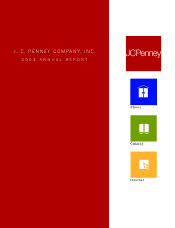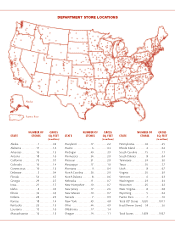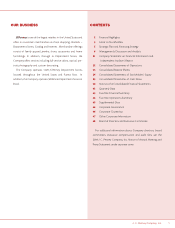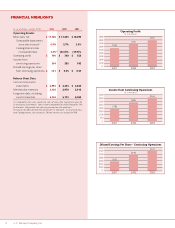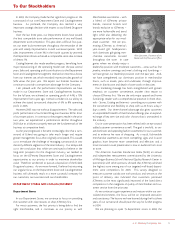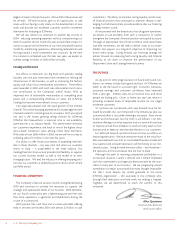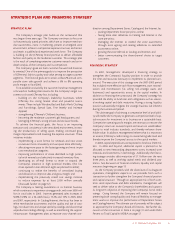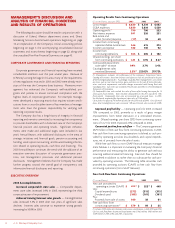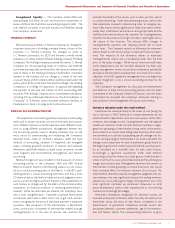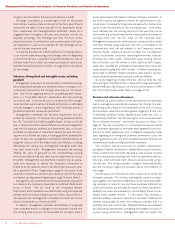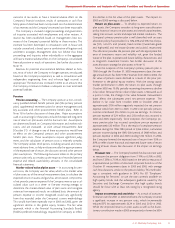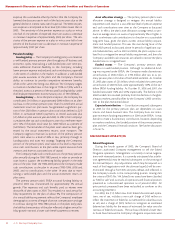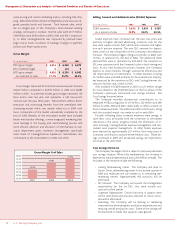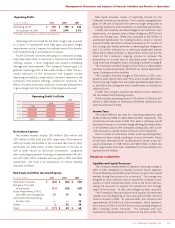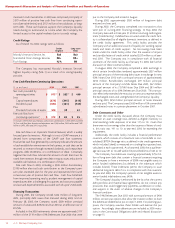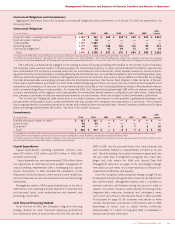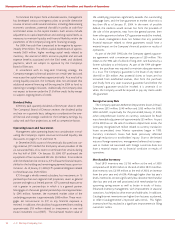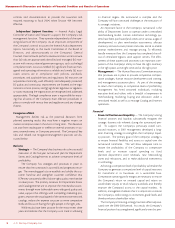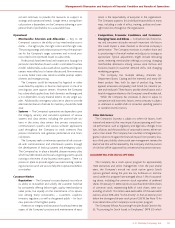JCPenney 2003 Annual Report Download - page 11
Download and view the complete annual report
Please find page 11 of the 2003 JCPenney annual report below. You can navigate through the pages in the report by either clicking on the pages listed below, or by using the keyword search tool below to find specific information within the annual report.
J. C. Penney Company, Inc. 9
Management’s Discussion and Analysis of Financial Condition and Results of Operations
outcome of tax audits to have a material adverse effect on the
Company’s financial condition, results of operations or cash flow.
Many years of data have been incorporated into the determination
of tax reserves and the Company’s estimates have been reasonable.
The Company is involved in legal proceedings and governmen-
tal inquiries associated with employment and other matters. A
reserve has been established based on management’s best esti-
mates of the Company’s potential liability in these matters. This
estimate has been developed in consultation with in-house and
outside counsel and is based upon a combination of litigation and
settlement strategies. Management does not believe that these
proceedings and inquiries, either individually or in the aggregate,
will have a material adverse effect on the Company’s consolidated
financial position or results of operations. See further discussion in
Note 19.
Reserves for potential environmental liabilities related to facili-
ties, most of which the Company no longer operates, are adjusted
based on the Company’s experience, as well as consultation with
independent engineering firms and in-house legal counsel, as
appropriate. The reserve was increased in 2002 to an amount that
the Company continues to believe is adequate to cover estimated
potential liabilities.
Pension:
Pension accounting — The Company sponsors a non-contrib-
utory qualified defined benefit pension plan (the primary pension
plan), supplemental retirement plans for certain management and
key associates and other postretirement benefit plans. Refer to
Note 15 for further discussion of these plans. Major assumptions
used in accounting for these plans include the expected long-term
rate of return on plan assets and the discount rate. Assumptions
are determined based on Company information and market indi-
cators, and are evaluated at each annual measurement date
(October 31). A change in any of these assumptions would have
an effect on the Company’s pension and other postretirement
benefit plan costs. These assumptions require significant judg-
ment, and the calculation of pension costs is relatively complex.
The Company utilizes third parties, including actuarial and invest-
ment advisory firms, to help evaluate annually the appropriateness
of the expected rate of return, the discount rate and other pension
plan assumptions. The following discussion relates to the primary
pension plan only, as it makes up the majority of recorded pension
expense and related asset/liability amounts in the consolidated
financial statements.
Market-related value of plan assets — In accounting for pen-
sion costs, the Company uses fair value, which is the market value
of plan assets as of the annual measurement date, to calculate the
expected return on assets and gain/loss amortization components
of net periodic pension expense. If the Company were to use a cal-
culated value, such as a three- or five-year moving average, to
determine the market-related value of plan assets and recognize
variances from expected results on a delayed basis, the amount of
pension expense or income recognized could vary significantly
from that recorded under the Company’s current methodology.
This would have been especially true in 2003 and 2002, given the
significant decline in the global equity markets. The fair value
approach, which is the Financial Accounting Standards Board’s
(FASB’s) preferred methodology, required the Company to reflect
this decline in the fair value of the plan’s assets. The impact on
2003 and 2002 earnings is discussed below.
Return on plan assets — To develop its expected return on
plan assets, the Company considers its long-term asset allocation
policy, historical returns on plan assets and overall capital markets,
taking into account current and expected market conditions. The
Company’s primary pension plan is well diversified with an asset
allocation policy that provides for a 70%, 20% and 10% mix of equi-
ties (U.S., non-U.S. and private), fixed income (investment-grade
and high-yield) and real estate (private and public), respectively.
This allocation provides the pension plan with the appropriate bal-
ance of investment return and volatility risk, given the funded
nature of the plan, its present and future liability characteristics and
its long-term investment horizon. See further discussion of the
asset allocation strategy for plan assets in Note 15.
Since the inception of the Company’s primary pension plan in
1966 through the October 31, 2003 measurement date, the aver-
age annual return has been 9.3%. However, from 2000 to 2002, the
fair value of pension assets declined as a result of the poor per-
formance in the global equity markets. With the strong capital
market performance in 2003, the return on plan assets through
October 2003 was 19.5%, partially recovering the previous decline
in fair value. Because the fair value of plan assets is measured as of
a point in time, the change in fair value between measurement
dates affects the subsequent year’s net pension expense. The
decline in fair value from October 2000 to October 2002 of
approximately $700 million negatively impacted the net pension
expense trend from 2001 to 2003. In 2001, net periodic pension
income contributed $76 million to pre-tax earnings. In contrast,
pension expense of $24 million and $130 million was incurred in
2002 and 2003, respectively. Since inception, the Company’s pri-
mary pension plan has incurred cumulative pre-tax expense of
approximately $32 million. This is the result of cumulative pension
expense during the 1966-1984 period of $366 million, cumulative
pension income during the 1985-2001 period of $488 million, and
pension expense in 2002 and 2003 totaling $154 million. In 2002,
the Company lowered the expected rate of return from 9.5% to
8.9% to reflect lower historical and expected future rates of return
among all asset classes. See discussion of the impact on earnings
below.
Discount rate — The Company lowered the discount rate used
to measure the pension obligation from 7.10% to 6.35% in 2003,
and from 7.25% to 7.10% in 2002, based on the yield to maturity of
a representative portfolio of AA-rated corporate bonds as of the
October 31 measurement dates in 2003 and 2002, with average
cash flow durations similar to the pension liability. This methodol-
ogy is consistent with guidance in SFAS No. 87, “Employers’
Accounting for Pensions,” to use the rate currently available on
high quality bonds and the subsequent guidance issued by the
Securities and Exchange Commission that high quality bonds
should be those with at least AA rating by a recognized rating
agency.
Impact on earnings and sensitivity — As a result of asset per-
formance over the 2001 to 2002 timeframe, the Company incurred
a significant increase in net pension costs, which incrementally
reduced EPS by approximately $0.24 in 2003 and $0.20 in 2002.
While the improved returns on plan assets as well as the discre-
tionary contribution made in 2003 are expected to lower the 2004

